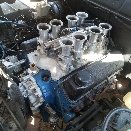-
Content Count
9,904 -
Joined
-
Last visited
-
Days Won
109
Reputation Activity
-
 gerg reacted to Thom in MSD 6AL-2 Programmable: Anyone Running Them?
gerg reacted to Thom in MSD 6AL-2 Programmable: Anyone Running Them?
Fuck yeah buddy, nothing like opening a box that contains a box of power inside
-
 gerg got a reaction from mcfly94 in Building a Clevo
gerg got a reaction from mcfly94 in Building a Clevo
Rule of thumb with determining wear on anything that's meant to be precision-machined: if your fingernail can grab on a score mark, it's rooted.
Just looking at the pics, it doesn't look good. Sleeving may be the only option on this block. 0.040" is too far already in my opinion, and generally 0.030" is the limit most people stick to on Clevos.
Not sure about cost these days but 10 years ago it was around $100 a pot to sleeve an engine.
-
 gerg got a reaction from PhatZJ in Bosch (copy) reluctor dizzy: regraphing?
gerg got a reaction from PhatZJ in Bosch (copy) reluctor dizzy: regraphing?
I've inherited this P--C--- dizzy with the motor, and already a couple of things have gone wrong. One of them was The vac advance can, which blew a diaphragm... No big deal, the points one slipped right in its place (thanks Mr Bosch).
Now, if I advance it up to cruise nice (with vac advance connected to manifold, not ported) it rattles it's head off under load at around 2500-4000 (where the meat of torque is made). But then when I retard base timing back to stop it pinging, it's doughy and unresponsive down low and cruises crap. It feels like it's getting way too much mechanical advance. This is on E10 by the way. Premium doesn't seem to bother it.
I've read on one other forum that these dizzys are set up with weak springs and give too much total timing.
Is there a way of limiting the total advance without having to take the dizzy somewhere and pay for a recurve? If I have to do that, that's already halfway to buying an MSD 6A programmable, which is what you really want anyway.
-
 gerg got a reaction from revhead in ADR 27a
gerg got a reaction from revhead in ADR 27a
As long as my arse points to the ground, they'll never, ever go backwards on emissions standards. Instead, the engineers carefully worked on combustion chamber design, cam profile, ignition and fuel maps to achieve the acceptable level of NOx emissions.
Using EFI has helped a lot, with being able to do things like cut fuel on over-run, greatly advance timing under light-loads/lean mixture, and richen mixture when needed.
By far the biggest advance was for EFI engines to be able to run oxygen sensors (once unleaded came along) for closed-loop operation, which keeps cruise mixture at an optimal ratio.
Modern, variable cam timed engines use different inlet/exhaust overlap on cruise/over-run to achieve an EGR effect when needed. They're pretty smart.
I haven't seen a petrol engine with an EGR valve for decades now, but most diesels still have them, and are very complicated with multiple coolers and electronic control, etc. In this case it's very much a vital part of the engine.
-
 gerg got a reaction from bear351c in Wondering What Weight/Brand oil to go on a just-ran-in Clevo?
gerg got a reaction from bear351c in Wondering What Weight/Brand oil to go on a just-ran-in Clevo?
Some diesel engine oils designed for older non-euro engines have higher zinc levels, which are good for flat tappet engines. They also have high detergent levels for better cleaning. If you see dirty black oil when draining, you should be happy. It's doing its job.
I'd use a 15W40 on an engine that young, maybe even a 10W30, but mineral oil in that grade I'm not sure about. I'd never use synthetic until completely bedded in.
60 grade is way too thick i my opinion, and will work the oil pump hard. Tight new engines run small clearances and thicker oil is actually worse as there is less flow and more heat involved. Less flow: less splash lube onto the cam, wiped lobes. Even after break-in this can happen.
-
 gerg reacted to Thom in K'archer Wet Sand Blasting: a review (sort of)
gerg reacted to Thom in K'archer Wet Sand Blasting: a review (sort of)
Fuck, improvement or what, not a bad little setup there, nice snowies are nice
-
 gerg got a reaction from Clevo120Y in Difference between a HYD and SOLID Cam
gerg got a reaction from Clevo120Y in Difference between a HYD and SOLID Cam
Hydraulic: street
Solid: race
There's an overlap between the two where you could have a racy hydraulic cam or a street solid, but the general rule is that solids are for higher rpm levels that hydraulics won't handle. Conversely, hydraulics are used on street engines because they are zero maintenance, quiet and are gentle on the valvetrain, sort of like a shock absorber. They normally last the life of an engine if used in mild applications.
If you want to know the reasons for either then you'll have to go right back to the start.
The valvetrain needs clearance between the rocker and the valve to allow for its expansion due to heat. If it was set up at zero cold, under heat the valve (especially the exhaust) would actually hold itself open, allowing gases to escape and you'd eventually burn out valves and seats. So to allow for the expansion, the clearances are often set when cold (some may be hot-set) and almost always the exhaust is looser than the inlet. An example might be 0.008" inlet and 0.014" exhaust. This is on a mechanical or "solid" valvetrain. This has to be checked and adjusted at regular intervals to allow for wear in all of the valvetrain components, eg every 20,000 km.
A hydraulic setup gives effectively zero clearance as the gap is taken up by oil pressure feeding into the lifter and filling a tiny cylinder inside. It also allows for wear on the valvetrain. As the cam comes onto lobe, a tiny valve inside the lifter shuts off and oil is trapped inside, and the lifter becomes pretty much solid. You might ask why the valves don't stick open when hot, due to the zero clearance... Well the litters have a very small amount of leakage so that they're always constantly pumping up and leaking back down to maintain the zero clearance.
Which brings us to why they don't like big rpm. At high speed, the lifter can actually start to leave the back of the cam lobe due to the valve spring not being able to push back enough and keep them in contact. The hydraulic lifter now sees that split second of no load as a clearance, and oil is pumped in to take it up. Then you have negative clearance.... And valves stuck open. That's what you call lifter pump-up. Ever thrashed your hydraulic-cammed engine for a while and noticed it running like a hairy goat afterwards, then come good again? That's the symptom right there. Pumping up and slowly bleeding back down again.
So then you install heavier valvesprings to cope with the rpm but there's a point where the internals of the hydraulic lifter can't cope with both the higher spring pressure and the high rpm loads.
Enter the solid lifter... It solves all those problems at the price of higher maintenance and (slight) noise.
Hydraulic cams can have a more aggressive ramp because the lifters have a fluid cushioning effect. Solid cams need a more gentle ramp because there is no cushion. What you give at one end, you get at the other. For this reason, neither type can interchange, unless a very particular application requires it.
Hope it all makes sense after all that.
-
 gerg got a reaction from Clevo120Y in Difference between a HYD and SOLID Cam
gerg got a reaction from Clevo120Y in Difference between a HYD and SOLID Cam
Hydraulic: street
Solid: race
There's an overlap between the two where you could have a racy hydraulic cam or a street solid, but the general rule is that solids are for higher rpm levels that hydraulics won't handle. Conversely, hydraulics are used on street engines because they are zero maintenance, quiet and are gentle on the valvetrain, sort of like a shock absorber. They normally last the life of an engine if used in mild applications.
If you want to know the reasons for either then you'll have to go right back to the start.
The valvetrain needs clearance between the rocker and the valve to allow for its expansion due to heat. If it was set up at zero cold, under heat the valve (especially the exhaust) would actually hold itself open, allowing gases to escape and you'd eventually burn out valves and seats. So to allow for the expansion, the clearances are often set when cold (some may be hot-set) and almost always the exhaust is looser than the inlet. An example might be 0.008" inlet and 0.014" exhaust. This is on a mechanical or "solid" valvetrain. This has to be checked and adjusted at regular intervals to allow for wear in all of the valvetrain components, eg every 20,000 km.
A hydraulic setup gives effectively zero clearance as the gap is taken up by oil pressure feeding into the lifter and filling a tiny cylinder inside. It also allows for wear on the valvetrain. As the cam comes onto lobe, a tiny valve inside the lifter shuts off and oil is trapped inside, and the lifter becomes pretty much solid. You might ask why the valves don't stick open when hot, due to the zero clearance... Well the litters have a very small amount of leakage so that they're always constantly pumping up and leaking back down to maintain the zero clearance.
Which brings us to why they don't like big rpm. At high speed, the lifter can actually start to leave the back of the cam lobe due to the valve spring not being able to push back enough and keep them in contact. The hydraulic lifter now sees that split second of no load as a clearance, and oil is pumped in to take it up. Then you have negative clearance.... And valves stuck open. That's what you call lifter pump-up. Ever thrashed your hydraulic-cammed engine for a while and noticed it running like a hairy goat afterwards, then come good again? That's the symptom right there. Pumping up and slowly bleeding back down again.
So then you install heavier valvesprings to cope with the rpm but there's a point where the internals of the hydraulic lifter can't cope with both the higher spring pressure and the high rpm loads.
Enter the solid lifter... It solves all those problems at the price of higher maintenance and (slight) noise.
Hydraulic cams can have a more aggressive ramp because the lifters have a fluid cushioning effect. Solid cams need a more gentle ramp because there is no cushion. What you give at one end, you get at the other. For this reason, neither type can interchange, unless a very particular application requires it.
Hope it all makes sense after all that.
-
 gerg got a reaction from Clevo120Y in Difference between a HYD and SOLID Cam
gerg got a reaction from Clevo120Y in Difference between a HYD and SOLID Cam
Hydraulic: street
Solid: race
There's an overlap between the two where you could have a racy hydraulic cam or a street solid, but the general rule is that solids are for higher rpm levels that hydraulics won't handle. Conversely, hydraulics are used on street engines because they are zero maintenance, quiet and are gentle on the valvetrain, sort of like a shock absorber. They normally last the life of an engine if used in mild applications.
If you want to know the reasons for either then you'll have to go right back to the start.
The valvetrain needs clearance between the rocker and the valve to allow for its expansion due to heat. If it was set up at zero cold, under heat the valve (especially the exhaust) would actually hold itself open, allowing gases to escape and you'd eventually burn out valves and seats. So to allow for the expansion, the clearances are often set when cold (some may be hot-set) and almost always the exhaust is looser than the inlet. An example might be 0.008" inlet and 0.014" exhaust. This is on a mechanical or "solid" valvetrain. This has to be checked and adjusted at regular intervals to allow for wear in all of the valvetrain components, eg every 20,000 km.
A hydraulic setup gives effectively zero clearance as the gap is taken up by oil pressure feeding into the lifter and filling a tiny cylinder inside. It also allows for wear on the valvetrain. As the cam comes onto lobe, a tiny valve inside the lifter shuts off and oil is trapped inside, and the lifter becomes pretty much solid. You might ask why the valves don't stick open when hot, due to the zero clearance... Well the litters have a very small amount of leakage so that they're always constantly pumping up and leaking back down to maintain the zero clearance.
Which brings us to why they don't like big rpm. At high speed, the lifter can actually start to leave the back of the cam lobe due to the valve spring not being able to push back enough and keep them in contact. The hydraulic lifter now sees that split second of no load as a clearance, and oil is pumped in to take it up. Then you have negative clearance.... And valves stuck open. That's what you call lifter pump-up. Ever thrashed your hydraulic-cammed engine for a while and noticed it running like a hairy goat afterwards, then come good again? That's the symptom right there. Pumping up and slowly bleeding back down again.
So then you install heavier valvesprings to cope with the rpm but there's a point where the internals of the hydraulic lifter can't cope with both the higher spring pressure and the high rpm loads.
Enter the solid lifter... It solves all those problems at the price of higher maintenance and (slight) noise.
Hydraulic cams can have a more aggressive ramp because the lifters have a fluid cushioning effect. Solid cams need a more gentle ramp because there is no cushion. What you give at one end, you get at the other. For this reason, neither type can interchange, unless a very particular application requires it.
Hope it all makes sense after all that.
-
 gerg reacted to Clevo120Y in Difference between a HYD and SOLID Cam
gerg reacted to Clevo120Y in Difference between a HYD and SOLID Cam
At least we said the same thing, that would have been awkward hahahaha
-
 gerg reacted to Clevo120Y in Difference between a HYD and SOLID Cam
gerg reacted to Clevo120Y in Difference between a HYD and SOLID Cam
Typing at the same time LOL
Your explination is better than mine
-
 gerg got a reaction from Clevo120Y in Difference between a HYD and SOLID Cam
gerg got a reaction from Clevo120Y in Difference between a HYD and SOLID Cam
Hydraulic: street
Solid: race
There's an overlap between the two where you could have a racy hydraulic cam or a street solid, but the general rule is that solids are for higher rpm levels that hydraulics won't handle. Conversely, hydraulics are used on street engines because they are zero maintenance, quiet and are gentle on the valvetrain, sort of like a shock absorber. They normally last the life of an engine if used in mild applications.
If you want to know the reasons for either then you'll have to go right back to the start.
The valvetrain needs clearance between the rocker and the valve to allow for its expansion due to heat. If it was set up at zero cold, under heat the valve (especially the exhaust) would actually hold itself open, allowing gases to escape and you'd eventually burn out valves and seats. So to allow for the expansion, the clearances are often set when cold (some may be hot-set) and almost always the exhaust is looser than the inlet. An example might be 0.008" inlet and 0.014" exhaust. This is on a mechanical or "solid" valvetrain. This has to be checked and adjusted at regular intervals to allow for wear in all of the valvetrain components, eg every 20,000 km.
A hydraulic setup gives effectively zero clearance as the gap is taken up by oil pressure feeding into the lifter and filling a tiny cylinder inside. It also allows for wear on the valvetrain. As the cam comes onto lobe, a tiny valve inside the lifter shuts off and oil is trapped inside, and the lifter becomes pretty much solid. You might ask why the valves don't stick open when hot, due to the zero clearance... Well the litters have a very small amount of leakage so that they're always constantly pumping up and leaking back down to maintain the zero clearance.
Which brings us to why they don't like big rpm. At high speed, the lifter can actually start to leave the back of the cam lobe due to the valve spring not being able to push back enough and keep them in contact. The hydraulic lifter now sees that split second of no load as a clearance, and oil is pumped in to take it up. Then you have negative clearance.... And valves stuck open. That's what you call lifter pump-up. Ever thrashed your hydraulic-cammed engine for a while and noticed it running like a hairy goat afterwards, then come good again? That's the symptom right there. Pumping up and slowly bleeding back down again.
So then you install heavier valvesprings to cope with the rpm but there's a point where the internals of the hydraulic lifter can't cope with both the higher spring pressure and the high rpm loads.
Enter the solid lifter... It solves all those problems at the price of higher maintenance and (slight) noise.
Hydraulic cams can have a more aggressive ramp because the lifters have a fluid cushioning effect. Solid cams need a more gentle ramp because there is no cushion. What you give at one end, you get at the other. For this reason, neither type can interchange, unless a very particular application requires it.
Hope it all makes sense after all that.
-
 gerg reacted to TiddleZ in Building a Clevo
gerg reacted to TiddleZ in Building a Clevo
Ok it's getting sleeved. Spoke to John at north Geelong Engine builders and he explained all the advantages, just like you guys say thicker walls much stronger bores etc and it will be grout filled to the Welch plugs. So it will be a damn near indestructible bottom end.
The only disadvantage is cost (1000 just to have the sleeves fitted bored and honed). But if you add it up, finding a virgin or very slightly bored clevo,paying good coin for it, then getting it machined etc would run into the thousands anyway, and it wouldn't be close to as solid as the sleeved block would be. Besides if I get t his done, even if it's Judy for a mild build, I'll always be able to use this same block again and again for a bigger and badder set up, right up to about 650 horsepower which is what the last clevo he built made, and it was sleeved.
-
 gerg got a reaction from mcfly94 in Building a Clevo
gerg got a reaction from mcfly94 in Building a Clevo
Rule of thumb with determining wear on anything that's meant to be precision-machined: if your fingernail can grab on a score mark, it's rooted.
Just looking at the pics, it doesn't look good. Sleeving may be the only option on this block. 0.040" is too far already in my opinion, and generally 0.030" is the limit most people stick to on Clevos.
Not sure about cost these days but 10 years ago it was around $100 a pot to sleeve an engine.
-
 gerg got a reaction from deankxf in K'archer Wet Sand Blasting: a review (sort of)
gerg got a reaction from deankxf in K'archer Wet Sand Blasting: a review (sort of)
One down, three to go...
-
 gerg got a reaction from steve mcqueen in K'archer Wet Sand Blasting: a review (sort of)
gerg got a reaction from steve mcqueen in K'archer Wet Sand Blasting: a review (sort of)
Just forked out $127 for a sand blasting attachment for my domestic model Karcher washer. I was apprehensive at first but I'm quite chuffed at the result so far (ok it was only half an hour usage). I tested it on a grubby snowflake that had some serious brake dust impregnated into it. I tried soap, hydrochloric acid and caustic soda and it just laughed at all of them. Mechanical means was the only option left to resurrect this set of classic rims.
Here are some visuals:
Back side:
First, some good points:
- unexpectedly good performance on alloy casting
- relatively clean compared to air blasting
- it's as portable as your pressure washer is.
- if doing small jobs, it's much more cost effective than outlaying for a massive air sandblasting rig.
- water keeps things cool.
Ok some bad points:
- a lot of money for basically a venturi attachment to a Karcher tip with a bit of cheap nylon hose to suck sand.
- the hose coils up and pulls the suction tip out of the bucket
- you get wet... A lot.
- you'll go through quite a bit of sand: count on a 10 litre bucket for each wheel.
I'll post some end-product pics when done.
-
 gerg got a reaction from steve mcqueen in Looking at buying a Corty, what to look 4
gerg got a reaction from steve mcqueen in Looking at buying a Corty, what to look 4
Check for rust where the rear lower control arms attach to the chassis. The pressing in the chassis rails overlaps and collects dirt/sand and rusts from the inside out, and is a critical structural point.
Sills can rot out, as do the tops of the front guards about 6" forward of the windscreen.
They don't stop or steer too well, particularly the sixes. They need stiff front springs and sway bar, and shocks to match. Go with nolathane (or similar) radius rod bushes.
They take a European 4-stud wheel pattern, same as Escort. Some Audi and SAAB wheels will definitely fit. Mine had 15" SAAB steelies.
If you plan to go manual, the shifter sits further forward than on a Falcon. They had a single rail that had a unique shift rail and extension housing.
Crossflow engines after '81 had no provision for the Cortina dipstick (near coil) so must be drilled to suit. They obviously use different sumps and oil pickups.
The heater box protrudes into the engine bay and comes close to the standard inlet manifold, limiting the choice of aftermarket ones you can fit in there.
They chew up starter motors as the solenoid sits right under the exhaust manifold, and the plastic solenoid cap cracks, and then no start. You can use a later starter with the solenoid mounted 90 degrees down but it hits on the firewall. I "clearanced" my firewall with a ball pein hammer.
TFs use completely different glass and doors all round, as the turret is actually 2" taller. Only the door skins are the same. The diffs are different too: TEs use 78 series, TFs used pissy 65 series, like a Sigma.
Being a 4-link rear, like a Torana or HQ, the top rear arms are angled so they move through opposing arcs and fight each other, chopping out the bushes in the diff housing, which are press-in jobbies. A shit design and an even shitter job to change them.
A limo diff is advisable, but will need an engineer's cert as they never came factory with them.
They are quite difficult, but not entirely impossible to have sex in. I lost my virginity on the front seat of mine. Yes it's important.
Overall, they're a pretty strong, well-built car that can take a flogging. They have plenty of character and put a big smile on your face. I miss my TF dearly to this day, and it's been 7 years.
-

-
 gerg got a reaction from steve mcqueen in Looking at buying a Corty, what to look 4
gerg got a reaction from steve mcqueen in Looking at buying a Corty, what to look 4
Check for rust where the rear lower control arms attach to the chassis. The pressing in the chassis rails overlaps and collects dirt/sand and rusts from the inside out, and is a critical structural point.
Sills can rot out, as do the tops of the front guards about 6" forward of the windscreen.
They don't stop or steer too well, particularly the sixes. They need stiff front springs and sway bar, and shocks to match. Go with nolathane (or similar) radius rod bushes.
They take a European 4-stud wheel pattern, same as Escort. Some Audi and SAAB wheels will definitely fit. Mine had 15" SAAB steelies.
If you plan to go manual, the shifter sits further forward than on a Falcon. They had a single rail that had a unique shift rail and extension housing.
Crossflow engines after '81 had no provision for the Cortina dipstick (near coil) so must be drilled to suit. They obviously use different sumps and oil pickups.
The heater box protrudes into the engine bay and comes close to the standard inlet manifold, limiting the choice of aftermarket ones you can fit in there.
They chew up starter motors as the solenoid sits right under the exhaust manifold, and the plastic solenoid cap cracks, and then no start. You can use a later starter with the solenoid mounted 90 degrees down but it hits on the firewall. I "clearanced" my firewall with a ball pein hammer.
TFs use completely different glass and doors all round, as the turret is actually 2" taller. Only the door skins are the same. The diffs are different too: TEs use 78 series, TFs used pissy 65 series, like a Sigma.
Being a 4-link rear, like a Torana or HQ, the top rear arms are angled so they move through opposing arcs and fight each other, chopping out the bushes in the diff housing, which are press-in jobbies. A shit design and an even shitter job to change them.
A limo diff is advisable, but will need an engineer's cert as they never came factory with them.
They are quite difficult, but not entirely impossible to have sex in. I lost my virginity on the front seat of mine. Yes it's important.
Overall, they're a pretty strong, well-built car that can take a flogging. They have plenty of character and put a big smile on your face. I miss my TF dearly to this day, and it's been 7 years.
-
 gerg got a reaction from steve mcqueen in Looking at buying a Corty, what to look 4
gerg got a reaction from steve mcqueen in Looking at buying a Corty, what to look 4
Check for rust where the rear lower control arms attach to the chassis. The pressing in the chassis rails overlaps and collects dirt/sand and rusts from the inside out, and is a critical structural point.
Sills can rot out, as do the tops of the front guards about 6" forward of the windscreen.
They don't stop or steer too well, particularly the sixes. They need stiff front springs and sway bar, and shocks to match. Go with nolathane (or similar) radius rod bushes.
They take a European 4-stud wheel pattern, same as Escort. Some Audi and SAAB wheels will definitely fit. Mine had 15" SAAB steelies.
If you plan to go manual, the shifter sits further forward than on a Falcon. They had a single rail that had a unique shift rail and extension housing.
Crossflow engines after '81 had no provision for the Cortina dipstick (near coil) so must be drilled to suit. They obviously use different sumps and oil pickups.
The heater box protrudes into the engine bay and comes close to the standard inlet manifold, limiting the choice of aftermarket ones you can fit in there.
They chew up starter motors as the solenoid sits right under the exhaust manifold, and the plastic solenoid cap cracks, and then no start. You can use a later starter with the solenoid mounted 90 degrees down but it hits on the firewall. I "clearanced" my firewall with a ball pein hammer.
TFs use completely different glass and doors all round, as the turret is actually 2" taller. Only the door skins are the same. The diffs are different too: TEs use 78 series, TFs used pissy 65 series, like a Sigma.
Being a 4-link rear, like a Torana or HQ, the top rear arms are angled so they move through opposing arcs and fight each other, chopping out the bushes in the diff housing, which are press-in jobbies. A shit design and an even shitter job to change them.
A limo diff is advisable, but will need an engineer's cert as they never came factory with them.
They are quite difficult, but not entirely impossible to have sex in. I lost my virginity on the front seat of mine. Yes it's important.
Overall, they're a pretty strong, well-built car that can take a flogging. They have plenty of character and put a big smile on your face. I miss my TF dearly to this day, and it's been 7 years.
-
 gerg reacted to dougie77 in Looking at buying a Corty, what to look 4
gerg reacted to dougie77 in Looking at buying a Corty, what to look 4
Rust will be your biggest thing to look for but like most cars the rust can be fixed
Check the boot floor pull out the spare as they rust in there
As stated above the top of guards and around the rear windscreen where the bootlid closes
Around the screens front and back roof gutters also
Sills get bad to but hey it can all be fixed
And yes you can have sex in one i also lost my virginity in one but it was a wagon so it was easier
And they are a lighter than a falcon with the same engine
-
 gerg got a reaction from revhead in Clevo open chamber heads...
gerg got a reaction from revhead in Clevo open chamber heads...
STD crank and rods, good for 7000rpm. A workmate builds 351s for his ski/race boat and uses 4MA cranks and reckons they're good for 7500. You won't need to spin it anywhere near that hard to meet your target. 400 hp is easy for clevo bottom end, just make sure it's all balanced.
Open chamber heads aren't as efficient as closed, and need a few more degrees of timing. They also need a split pattern cam with more exhaust duration to scavenge the larger chamber. Std comp is 9.2:1 from memory. Give them a skim down 20-30 thou, (any more might affect your pushrod length), and that will take the compression up maybe half a point.
I didn't catch whether you've got 2Vs or 4Vs, but I assume they're 2Vs. In that case, they respond well to cleaning up around the bowl and short turn, and maybe take a bit out of the roof at the mouth, both inlet and exhaust.
Don't go for too much of a cam. Torque is what V8s are all about, and a grumpy, peaky engine will give you the shits in no time.
-
 gerg got a reaction from Thom in Clevo open chamber heads...
gerg got a reaction from Thom in Clevo open chamber heads...
I can back that up to some degree. My mild 302 pings its tits off on E10 but loves 98. It's only a skimmed closed chamber so it would be 9.5:1 max. Backing off the timing enough to stop it rattling makes part-throttle too doughy, even with vac advance hooked up to manifold vac. MSD programmable for Christmas please?
The clincher is the cam; it's only a Crow 270/280 (or 206/214 @ 0.050") so at peak torque, at around 2500 rpm, it rattles something chronic. A bigger cam could help but iron heads are considered old fashioned for a reason.
-
 gerg got a reaction from Thom in Clevo open chamber heads...
gerg got a reaction from Thom in Clevo open chamber heads...
I can back that up to some degree. My mild 302 pings its tits off on E10 but loves 98. It's only a skimmed closed chamber so it would be 9.5:1 max. Backing off the timing enough to stop it rattling makes part-throttle too doughy, even with vac advance hooked up to manifold vac. MSD programmable for Christmas please?
The clincher is the cam; it's only a Crow 270/280 (or 206/214 @ 0.050") so at peak torque, at around 2500 rpm, it rattles something chronic. A bigger cam could help but iron heads are considered old fashioned for a reason.
-











